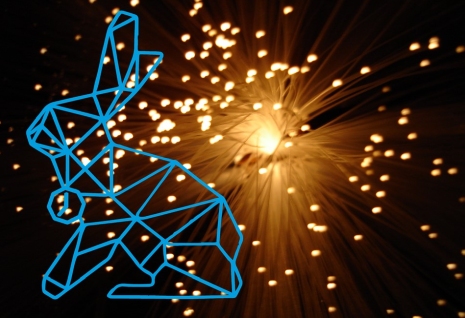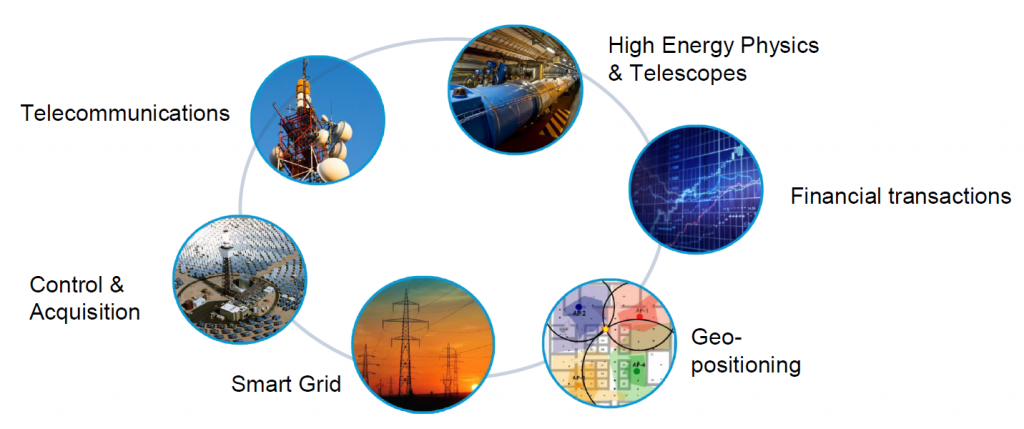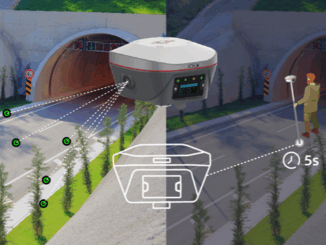
Exploring the esoteric world of precision timing by “following the White Rabbit”.
By Gavin Schrock, PLS
While most in the AEC, geospatial, and geomatics sectors might only have positioning and navigation in mind when it comes to PNT, we cannot overlook time. Our wired work and lives rely on—almost over-rely on—the precise time that GNSS provides. Computing networks, cellular networks, IoT, the cloud, anywhere computing, real-time positioning, reality capture, and so much more… through time synchronization these have reached the levels of enhanced performance that we have become accustomed to…. and take for granted.
As a follow-up to our April 18, 2021 feature “Progress in Addressing GPS/GNSS Vulnerabilities” where we examined the vulnerabilities, but also the positive steps being made to proactively solve the issues, we offer this, the first installment of a series where we explore Alt PNT technologies and the present work of developers and solution providers.
Timing Evolves
“30 years ago, much of the conversation was about PDHs, packet data that sort of handled timing, so as timing was implicit there, people did not understand and even did not notice why it was so critical and important” says Carlos Frias, sales engineer with Seven Solutions. Seven Solutions S.L. is a telecommunications company based in Spain that provides accurate sub-nanosecond time transfer for reliable industrial and scientific applications.
PDH, or plesiochronous digital hierarchy is a technology used in telecommunications networks to transport large quantities of data over digital transport, or equipment such as fiber optics and microwave radio systems. Cool; we may not understand, as end users, what or how this worked all these years, but rely on it we do. But things have changed.
The legacy packet painted world, we have inhabited for the early decades of the digital and web revolution, has served us well enough to become complacent in the face of potentially serious disruptions. It is not just the over-reliance on GPS/GNSS delivered precise time, but that all legacy systems, be those wire or fiber, are also vulnerable. There are many newer approaches to PDH and emerging alternatives that seek to keep up with the insatiable demand for massive data transfer. And this means the stakes are much higher when it comes to protecting the flow.
The solution for many who shepherd this data-storm for us is to follow the White Rabbit. White Rabbit (WR) is a relatively recent wave of development to modernize data and control systems, with precise, secure, and resilient time transfer as a prime factor. Much of the initial impetus has come from the research titan CERN, as did key elements of what was to become the world wide web. While WR has, as has been implemented and continues to develop across multiple industries and institutions, individual developers have concentrated on specific use cases and solutions.
CERN for example has concentrated first on renovating their own systems. Technology-wise, CERN’s White Rabbit Network (as their site notes) is a Bridged Local Area Network with VLANs that uses Ethernet to interconnect switches and nodes, and a precision time protocol to synchronize them. Precise time client bases for firms like Seven Solutions have very specific needs, but the core elements of WR remain the same. While essentially born at CERN, Seven Solutions began integrating WR tech into commercial solutions for ultra-accurate and deterministic time transfer in 2010.
Anticipating and Dealing With Vulnerabilities
Spoofing, jamming, inadvertent interference, spectral policy changes, and technological entropy are threats to reliance on GNSS for precise time (not to mention navigation and positioning).
When it comes to precise time, terrestrial routes like Ethernet and fiber can serve as the fail-over for space-based time transfer. This is where firms like Seven Solutions come in to play. They have developed solutions that overcome systematic weaknesses of terrestrial routes: limitations over distance, or how many hops the precise time can make, and lack of resilient backups of their own.

A simplified example of a White Rabbit implementation to provide resilience in precise time for data networks. There are many, more complex and scalable topologies that can be addressed – Source Seven Solutions
If you lose the signal from GNSS we can deliver the time to you via another route with sub nanosecond accuracy and even close to the sub-100 picoseconds depending on the optical path and the elements throughout it ” says Frias. “For example, if location A is far from location B and there is some jamming or spoofing affecting A, and you are not having the same threat at B, we manage the hops to serve A.” And if the same GNSS issue is happening at both, a source with say an atomic clock can be put in the mix to serve all affected locations. Benefiting from Ethernet and Fiber, you can turn to White Rabbit time distribution.
Riding the Infrastructure
Whatever routes are taken, this physical layer means leveraging existing data/communications infrastructure, but distance is a factor. This is not as much of an issue as it might seem; Frias says one of his favorite examples is up to 1000km using DWDM over a public telecom fiber network, though a strategy for a client might involve beefing up or densifying existing routes. In highly developed and infrastructure rich environments like North America, Europe and much of Asia, the distance limitations can be moot. And that the geographic reach of a client may not be very extensive and the scope of what they are doing may be relatively narrow.
What the various precise timing end user constituencies are looking for is a stable and validated environment. “There are different lines of working here“ say Frias. “One of them is connected with the origin of the protocol, the Science Sector, that has its own specific requirements. For instance, a National Institute of Metrology. The other is the industry, for which Seven Solutions is developing some new features to complement the solutions.” For this particular application, they developed a failover algorithm to have multiple data sources in one location.

Key sectors for precision timing – Source Seven Solutions
“Another is the Fintech Sector, in which we are one of the leaders, like a high-volume trading company; they use the timing in order to measure the latency of the trading day operations,” say Frias. “So, if you don’t implement the proper timing mechanism, you are not going able to measure the latency correctly or trades might not be fair for all of the customers—that could be quite a liability and regulatory compliance considerations. This is their main goal. They have to ensure the fairness of the network.”
And likewise, the ante has been upped in telecommunications with the arrival of 5G that has very demanding timing needs. For example, a use case of a telecom provider that is trying to develop two different networks: one for timing and frequency synchronization, and another for data. The synchronization layer is there to ensure that all the very demanding timing and frequency requirements are met. They use GNSS for timing, but are also assisted by Seven Solutions, connected through fiber optics. So, in this way that they can ensure that all of the network elements, and by extension all end uses, are going to be synchronized in time and frequency with sub nanosecond accuracy and picosecond precision.
This can ensure that the downstream of the network, or the layers below the backbone are going to be perfectly synchronized since the time budget will be optimized. “Furthermore, our devices also offer interoperability protocols (PTP v2, NTP, etc.) with the lead layers below the backbone,” says Frias. The deeper technical details of what goes on in their solutions is something complex to explain, but keep in mind that for example in the early days of high precision GNSS, many of the finer details were held close to the chests of the developers; we sufficed to see and verify the results to eventually trust in and rely on the tech.
Alt PNT Elevated
And while there has been a lot of recent talk about PNT vulnerabilities, often in sensationalist doom-gloom tones, there has been encouraging, sober examinations of the subject, and some high-profile testing.
A recent study was undertaken by the US Department of Transportation, where solutions from 11 Alt PNT solutions were tested under controlled conditions at two defense facilities in 2020. Note that all of the solutions were not necessarily seeking to solve for all aspects of PNT, and indeed, the 2021 Report to Congress of results released emphasizes the reality of Alt PNT: no one-size fits all.
The technology demonstrated for the USDOT tests by Seven Solutions S.L. is based on the White Rabbit (WR) protocol for sub-nanosecond time distribution over optical fiber networks for precise synchronization of clocks in packet-based networked systems. They did well in the tests, their solutions were the most accurate and note that since, they have further developed a full failover mechanism that evaluates multiple timing sources and include a holdover mechanism when none of them are available. Says Frias, “our devices are now much better than the ones that were tested there thanks to those tests and results.”
Time Forward
Frias spoke of other timing applications, like huge radio telescope arrays and enclosed systems, like on a multi-stage micro launcher where the internal time synchronization must be error free by using Time Sensitive Networking. One challenge of implementing precise time alternatives in existing infrastructure is that some legacy data paths were not designed to handle both time and data. “There is information technology and operational technology, and sometimes those do not mesh very well, although there are mechanisms to overcome these matters” say Frias. Seven Solutions has tackled this and offer solutions that can, in most cases, be implemented without having to alter existing infrastructure.
Some Alt PNT solutions themselves rely on GNSS. As any signal ranging approach requires precise time, if the source is GNSS, then the Alt PNT itself would be compromised if GNSS is. There is long history of terrestrial positioning and navigation solutions; radio beacons, navigation aids, “pseudolites” (that act like a GNSS satellite but are on the ground in networks). While some of these kinds of solutions seek to solve timing by putting an atomic clock at towers, others use net/fiber for essential time synchronization, and this is another area where Seven Solutions provides this.
Alt PNT will be in play for the current space boom. There are satellite systems doing SAR, LiDAR, imaging, etc. And increasingly these come in the form of constellations of small satellites at low altitudes, doing data collection and mapping, with real time feedback. They need to be time synchronized with the ground control, and in some implementations with each other—and most are too small to carry (or afford) an on-board atomic clock. Their simple on-board clocks can be constantly synchronized from their respective ground control segment stations, but those need precise time. Especially if a constellation of such satellites seeks to (or says they will at some future date) provide positioning and navigation—the irony of Alt PNT that needs Alt PNT!
Seven Solutions, a Spanish firm that took its name from seven former students at the University of Granada, grew from science and academia. They continue to apply the same principles of research to the development of these precise timing solutions for commercial and defense applications. Precise time might seem an esoteric world that few of us get a glimpse of, is more important than we imagine, and we take for granted. As our respective PNT dependent professions and industries consider how we approach support of and advocacy for Alt PNT, we might want to put additional emphasis on the “T” in PNT, and maybe take a deeper look into this temporal world. And as Alice and Neo did: “follow the White Rabbit”.
Update: On December 9, 2021 the aquisition of Seven Solutions by the Orolia Group will have completed. Orolia is another prominent Alt PNT firm that GoGeomatrics has profiled: “Alternate GPS/GNSS/PNT – Orolia”.





Be the first to comment